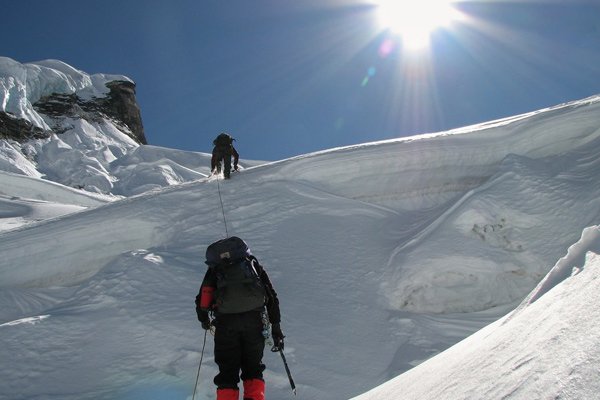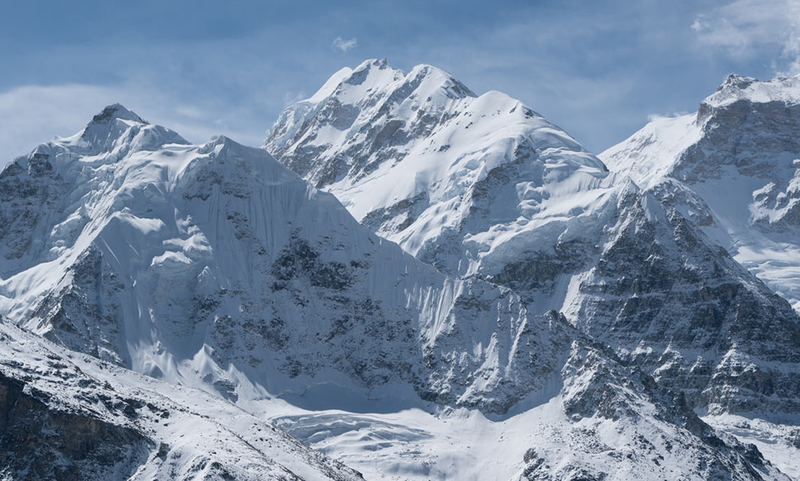Trip Overview
Mt. Jopuno at an elevation of 5603 meters is an alluring trekking peak in Sikkim. It lies inside the Kanchendzonga National Park in the western part of Sikkim and shares the same route as the Dzongri - Goechala trek route till the base camp. The peak is visible throughout Okhlathang valley while trekking towards the famous Goechala trek.
Mt. Jopuno has been an object of attraction for climbers and thrill-seekers since its inception by the government of Sikkim as a trekking peak. This Expedition offers climbers and trekkers captivating and panoramic views of some of the mesmerizing peaks and mountains of the Sikkim Himalayas.
While embarking on the expedition to Mt. Jopuno climbers also have the opportunity to explore pristine and beautiful places like Dzongri, Dzongri la, Goechala, and other gorgeous alpine valleys and meadows. All these places are famous for their supreme serenity as well as paramount exquisiteness.
This Expedition trip to Mt. Jopuno is ideal for the climbers, trekkers, and adventure seekers who have an inclination towards nature's magnificence and wants to satiate their need for contentment and thrill.
Trip Highlights
1) Pristine Peak - Summit Mt. Jopuno Peak, the beautiful alluring peaks in Sikkim.
2) Gorgeous Breath-taking views - Get a close-up view of some of the most beautiful peaks of Sikkim from close proximity along with mesmerizing meadows and valleys.
3) Yuksam - The first capital of Sikkim and a base camp of famous Goechala Kanchendzonga Trek and several Mountain Expeditions. The Oldest monastery of Sikkim, Dubdi Monastery is located at Yuksam. The Famous Coronation Throne where the first king of Sikkim was crowned by the three religious monks is in Yuksam.
4) Tshoka - A small Refuge settlement at the height of 3000m. A first-day camping point of the trek. From Tshoka one can see a glimpse of towering snow-capped mountain peaks - Mt. Pandim and a few others.
5) Dzongri Viewpoint - The most beautiful and ideal viewpoint of high-altitude treks in Sikkim. One can witness a 360-degree view of the Pristine and Panoramic 16 snow-capped mountain peaks and hills. Located at the height of 4250m Dzongri Viewpoint offers sublime and captivating scenery of the entire Himalayan range.
6) Laxmi Pokhari (Lake) in Dzongri - A pristine high-altitude lake situated a 3-hour walk from the Dzongri Campsite
7) Samiti lake - One of the most pristine and holy high-altitude lakes in Sikkim. It lies exactly Infront of Mt. Kanchendzonga and is a treat to witness on a clear sunny day.
8) Goechala Viewpoint - The closest point to Mt. Kanchendzonga - The guardian deity of Sikkim! The Goechala viewpoint provides a sublime and closest view of Mt. Kanchendzonga and Mt. Pandim. One can have the closest look at Thalung Glacier too at the bottom of Mt. Kanchendzonga.
9) The mountains and peaks of Sikkim are less conquered. This itself makes it challenging and worth trying for.
Health and Fitness
You have to be Fit and Healthy to undertake the Mt. Jopuno Expedition. Trekking for 6 to 7 hours a day in high Himalayan foothills is one of the most important requirements for this high-altitude trek and Expedition. Apart from good health conditions basic mental preparation and determination are also very important.
People suffering from Acute Heart and Lung diseases, Asthma, and High blood pressure are not recommended to take up this Expedition Trip.
To complete this high-altitude trek and climbing Expedition regular exercises like running, skipping, aerobics, and long-distance uphill trekking (4 to 5 times a week) are highly recommended as one needs lots of stamina and endurance to succeed climbing with a backpack on your back. One should start making basic physical preparation at least 2 months before the Expedition.
Prior training, trekking experience, and mental determination are crucial for Mt. Jopuno Peak climbing. If you have already walked above 3000m above sea level, you know much about the Himalayas. While climbing Mt. Jopuno, you need to use the basic climbing equipment appropriately. Don’t worry if you have no idea about it! Our professional climbing guide will train you how to use those gears and equipment before the summit push.
The packing of right and comfortable clothing also makes a difference in the completion of the Expedition, so it is necessary to be disciplined while packing your clothing and gear for the Trip. You can contact us for help with clothing gears and packing!
During the Expedition, we provide a basic medicine Kit that includes Medicine for High Altitude sickness, Headache, Diarrhoea, Vomiting, Common Cold, etc. All of our medicine is scientific medicine purchased in India, however, we advised you to bring your small medicinal kit for the trip if possible.
Trekking/Tour Tips
1. A common tendency among young blood and beginners is to show enthusiasm by walking fast with excitement. Even the experienced sometimes try to show off by walking fast, this is soon exhausting and not recommended. Walk slow - warm up gradually and continue at a slow comfortable pace before pushing yourself a little more.
2. Develop a personal rhythm. Maintain your steps to synchronize with breathing. This will help minimize getting out of breath.
3. Walking in Himalayan trails with loose soil, rocks, ice, and snow is tricky. So, avoid stepping on loose soil and rocks and place the foot flat and firm with a better grip. Always follow the rule ‘heel first’ while walking on the Himalaya trail.
4. Walking in a zigzags manner while ascending on a very steep slope is advisable. While descending walking zigzag is a good technique to avoid excessive pressure on knees and avoid knee pain and blisters.
5. Avoid stepping on loose stones and soil to avoid an accident.
6. Avoid overtaking fellow travelers on a narrow trail. Only Overtake at comfortable wide space if necessary.
7. While ascending and descending a slope or over loose stones, leave sufficient space between the next person so that any stone rolling down does not hit trekkers below.
8. Do not run down a slope. Bend knees a little while descending. Dig heels into soft snow or soft ground.
9. Our Himalayan condition is mostly wet so avoid wet grass, wet roots, and the muddy zone which can be very slippery. Be careful while walking on them.
10. Shortcuts on a foot trail should be avoided.
11. Always put on warm clothing while taking a rest. This will help avoid getting cold, cough, and high-altitude sickness
12. Respect the sentiments and traditions of the local hill people.
13. Always carry enough water in your water bottle as water is essential in avoiding altitude sickness.
14. Wear a comfortable and right set of trekking boots, pants, and jackets. Avoid wearing new trekking boots directly for the Trek. Get used to it by wearing it before the trek. Carry all necessary clothing.
15. Need to build up good physical fitness as you will be climbing under some challenging circumstances such as thin oxygen lands, deep snow, and extreme cold.
16. Need to be familiar with crampons, ice ax, walking roped-up, and other basic climbing gears. Previous climbing experience is advantageous but not mandatory.
Halts and Rests:
1. While taking a rest, lie against a tree trunk, a big stone, or on flat ground. Place your legs on your bags or any other higher ground. This helps regulate blood circulation.
2. Stop at any comfortable point after the first start to readjust your rucksack, jackets, or tie a shoelace for better comfort and adjustment.
3. Do not make frequent or prolonged halts. Too many small stops destroy the walking rhythm. Frequent rests are not helpful. You should follow your own rhythmic walking pace and technique to avoid unnecessary tiredness. A stop should be made only at natural stopping points, like on the top of a ridge, before an ascent, or at a scenic viewpoint.
4. Stop and place yourself on the safer (Mountain) side to give way for the pack animals to pass through. Avoid bags carried by the animals that can push you. Be aware of the yak's horn too.
FAQ (Frequently Asked Questions)
WHERE IS Mt. JOPUNO PEAK LOCATED
Mt. Jopuno, the beautiful alluring trekking peak of Sikkim lies inside the Kanchendzonga National Park in the western part of Sikkim. Yuksam is the last village before heading for Mt. Jopuno Expedition with a motorable road connection.
HOW TO REACH YUKSAM
The closest Airport to Yuksam, Sikkim is PAKYONG AIRPORT & BAGDOGRA AIRPORT. You have to fly either to Bagdogra Airport or Pakyong Airport. From there you can drive to Yuksam with a private reserve vehicle.
Pakyong Airport is around 6 hours’ drive and Bagdogra Airport is around 7 hours’ drive from Yuksam.
HOW DIFFICULT IS Mt. JOPUNO PEAK CLIMB
Elevated at 5603 m (18,383 ft) above the sea surface, Mt. Jopuno is one of the most beautiful and thrilling climbing peaks for professionals as well as for first-timers and novice climbers. Previous alpine climbing experiences are beneficial but it is not mandatory to climb Mt. Jopuno.
The climb involves above 5500m height with some difficulties so one needs to be physically fit, healthy, and used to high-altitude trekking with basic knowledge about climbing gears and equipment.
DO YOU PROVIDE TREKKING GEAR AND EQUIPMENT FOR Mt. JOPUNO EXPEDITION
We provide you with all the necessary gears and equipment however there are certain climbing gears that you need to bring along yourself. We will update you on such gear and types of equipment over email.
WHAT GEARS AND CLOTHING TO CARRY FOR Mt. JOPUNO EXPEDITION
No matter what season you are planning to climb the mountains are always going to be cold, rough, and tough so it is necessary to pack yourself with adequate and proper clothing. Here is the standard kit checklist for the Mt. Jopuno Peak Expedition.
Proper packing of the trekking and expedition gears is necessary with eyes on the weight limit. It is important to have a good brand of clothing and climbing gear.
Basic Gears:
BackPack & rain cover or Duffel bag (50 to 70 ltr)
Day Pack & rain cover (20 to 30 ltr)
Walking stick (1 pair or at least one)
Water Bottle (2 bottles of 2 ltr each)
Thermos flask (1 nos)
Head Light (1 Nos with 4 pairs of batteries)
Gaiters (1 pair)
Upper and Lower Clothings:
T-Shirt (2 to 3 full sleeves). Mostly noncotton
Fleece T-shirt (1 nos)
Thermal Inner-wears or base layers (1 nos or 1 pair) such as long jones
Fleece Jacket (1 nos)
Down, Feather, or Holofil Jackets (1 nos)
Wind and Waterproof jackets & pants (1 pair)
Trekking Pants (1 pair). Comfortable and durable
Short Trekking Pants (1 nos or 1 pair)
Poncho (1 nos)
Headgears:
Woolen cap (1 nos)
Sun cap (1 nos)
Balaclava or scarf (1 nos)
Sunglasses (1 nos) U/V protected and dark
Hand gears:
Waterproof gloves (1 nos)
Woolen gloves (1 nos)
Feet gears:
Waterproof Trekking boots (1 nos) preferably ankle high Goretex, North face, Colombia or Quechua
Snickers or running shoes (1 nos) preferably from any reputed brand
Gaiters (1 nos)
Sandals or flippers (1 nos)
Cotton socks (4 pairs)
Woolen socks (2 pairs)
Personal utilities:
Sunscreen cream
Moisturizers
Hand sanitizers
Toilet papers and wipes
Anti-bacterial powders
Lip balm
Toothbrush and toothpaste
Climbing gears:
Climbing Boots
Crampons
Ascender (Jumar)
Descender (Figure of Eight Lock)/Super 8
Screw Gate/Carabiner/Karabiner
Ice Axe
Helmet-UIAA Test
Harness
Trekking Pole
Insect Repellent
Sleeping Bags
Prusik Rope/ Infinity Dry Rope
Climbing Rope
Survival Blankets
Altimeter
Oximeter
Snow Bar
Ice Screw
Braking Belay Device
U-Lock
WHY CONTINGENCY OR EXTRA DAYS ARE NECESSARY WHILE CLIMBING Mt. JOPUNO PEAK
Contingency days are crucial in mountain climbing and expedition. Due to the bad weather, the mountaineers may suffer from altitude sickness or summit push might not be possible on the targeted day. So, you need to wait for the perfect weather to summit the peak. If they are not favorable, you need to wait until they become favorable. Thus, contingency days are important in such expeditions.
CAN I EXIT YUKSAM ON THE LAST DAY OF THE Mt. JOPUNO EXPEDITION DIRECTLY
Yes, you can if you are looking to reach any other location near to Yuksam OR if it is too urgent and necessary. Driving to Airport and Railway directly after the expedition is not recommended.
We will advise not to plan to leave Yuksam directly after the last day of the expedition as it will be too tiring and hectic. Driving at night on the Himalayan road is not comfortable and enjoyable.
The earliest you will reach Yuksam on the last day of the expedition is around 1 pm so long hours drive thereafter is not possible.
CAN I LEAVE EXTRA BAGS AT YUKSAM AND COLLECT THEM ON THE LAST DAY OF THE Mt. JOPUNO EXPEDITION
Yes, you can keep a bag of clothes at Yuksam and collect it after the trek. We will advise you to leave one set of clothing at Yuksam for the last day as normally pack animals arrive late on the last day of the trek.
You can even keep valuables and cash at our office safely and collect them after the trek.
WHAT DOCUMENTS NEED TO BE CARRIED FOR Mt. JOPUNO EXPEDITION
Indian trekkers must carry identification documents such as VOTER ID CARRD, DRIVING LICENSE, AADHAR CARD, INDIAN PASSPORT, Medical Insurance, Medical fitness certificate, and self-declaration to undertake the expedition along with 8 pcs PASSPORT SIZE photograph. Original documents need to be carried along.
Foreigners need to carry INDIAN VISA, PASSPORT, SIKKIM INNER LINE PERMIT, Medical Insurance, Medical fitness certificate, and self-declaration to undertake the expedition along with 8 pcs PASSPORT SIZE photograph.
Original documents need to be carried along.
IS THERE CONNECTIVITY DURING Mt. JOPUNO EXPEDITION
There is no phone connectivity during the Mt. Jopuno Expedition. Yuksam is the last village where you can get a phone and internet connection.
At certain specific locations between Yuksam to Tshoka, you can get Vodafone, Airtel, and Jio networks. Even at Tshoka and Phedang, you can get a phone network if the weather condition is favorable.
There is no electricity throughout the Mt. Jopuno expedition.
HOW IS THE WEATHER & TEMPERATURE DURING THE Mt. JOPUNO EXPEDITION
There are two distinct seasons for doing the Mt. Jopuno expedition. Mid-March, April to May (Spring) and Mid-September, October to November (Autumn). Normally weather remains good and clear in those given periods however there is no guarantee as weather is extremely unpredictable in our Himalayas and does change within hours and days.
The temperature at each campsite depends largely on each day's specific weather condition.
Spring (Mid-March, April till May)
* Yuksam to Tshoka
Morning and Evening – 12 to 16 degrees centigrade
Day time – 18 to 24 degrees centigrade
Late Evening and Mid Night – 8 to 14 degrees centigrade
* Phedang, Dzongri, and above
Morning and Evening – 4 to 12
Day time – 12 to 18 degrees centigrade
Late Evening and Mid Night – minus 10 to 4 degrees centigrade
* Advance Base Camp and above
Morning and Evening – minus 10 to 6 degrees centigrade
Day time – 0 to 16 degrees centigrade
Late Evening and Mid Night – minus 18 to 0 degrees centigrade
Autumn (Mid-September, October till November)
* Yuksam to Tshoka
Morning and Evening – 8 to 14 degrees centigrade
Day time – 16 to 21 degrees centigrade
Late Evening and Mid Night – 2 to 10 degrees centigrade
* Phedang, Dzongri, and above
Morning and Evening – minus 8 to 10
Day time – 2 to 14 degrees centigrade
Late Evening and Mid Night – minus 15 to 2 degrees centigrade
* Advance Base Camp and above
Morning and Evening – minus 12 to 4 degrees centigrade
Day time – 0 to 12 degrees centigrade
Late Evening and Mid Night – minus 20 to 0 degrees centigrade




 Dear
Dear
 Dear
Dear Dear
Dear






